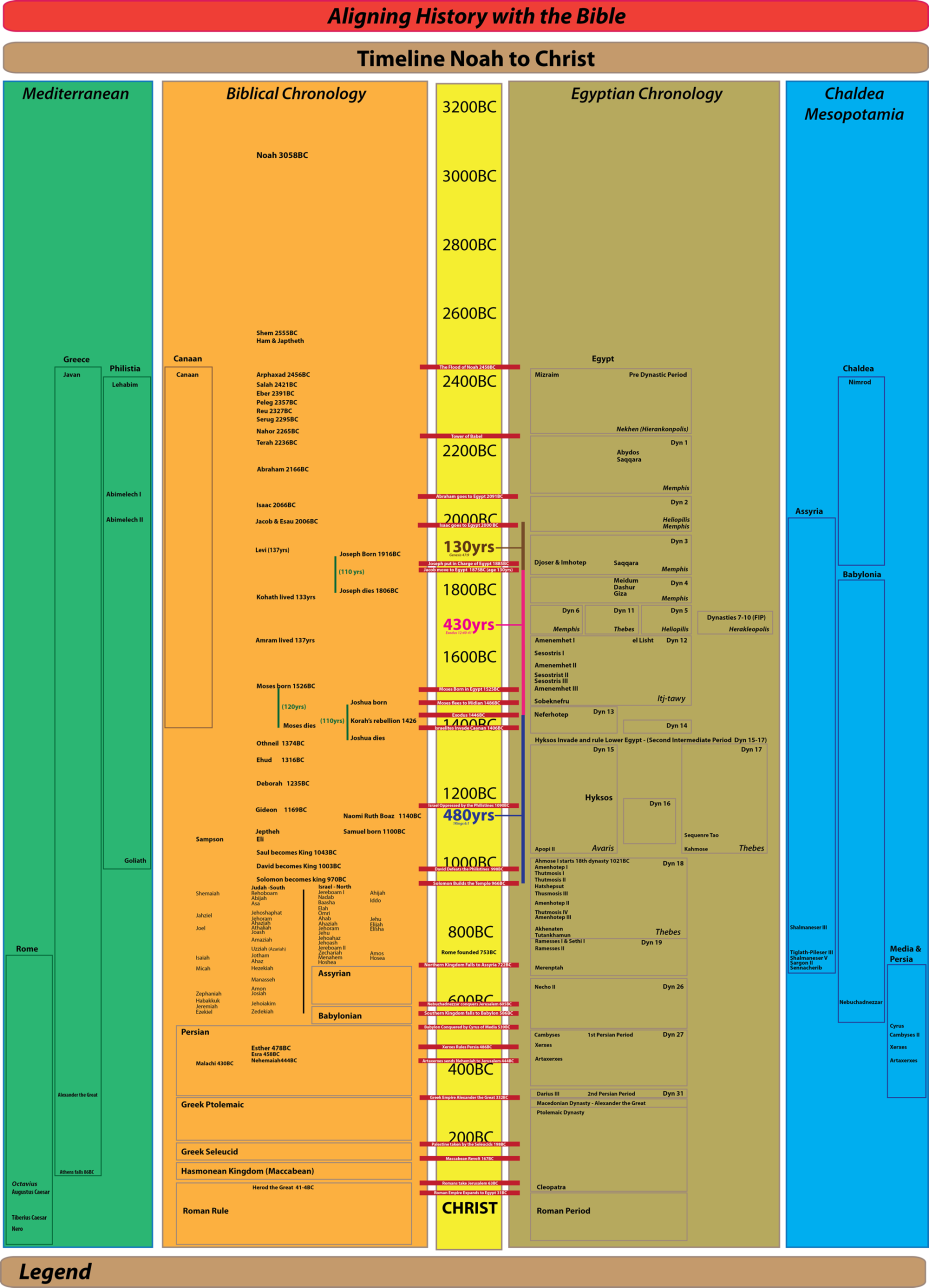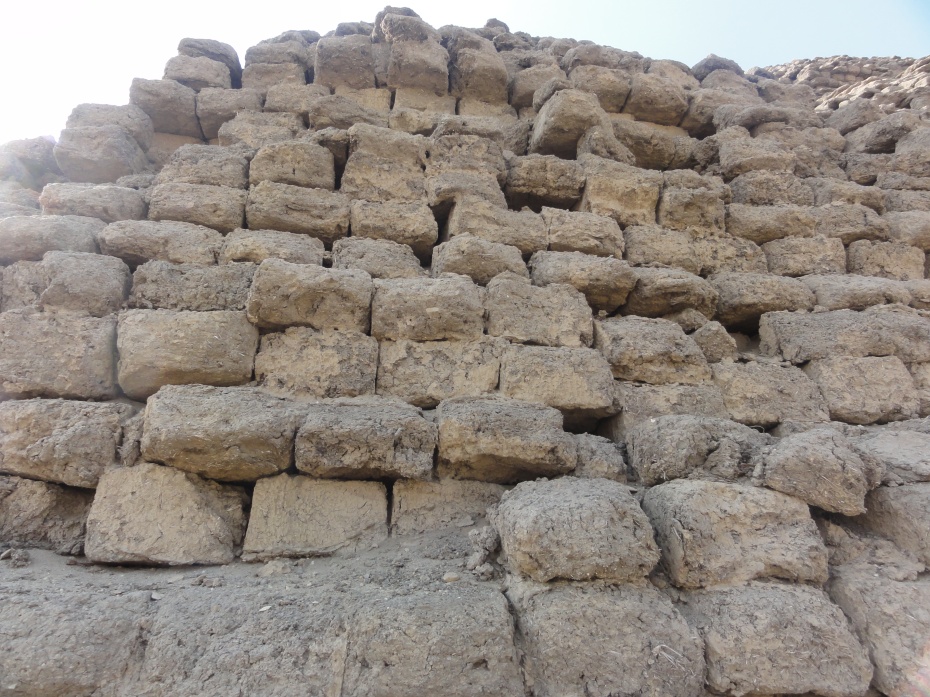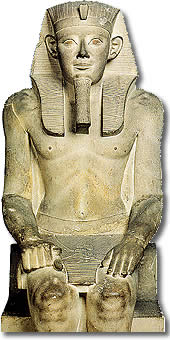Posts Tagged With: mud bricks
History aligned with the Bible
The Pharaoh when Moses was Born (Amenemhet III)
The Pharaoh when Moses was Born
Moses/Amenemhet IV was 80 years old when he lead the Israelites out of Egypt in 1446BC. The Israelites were in Egypt for 430 years. Moses was born 80 years before the Exodus in 1526BC. The Israelites, therefore, had been in Egypt for 350 years when Moses was born. Joseph/Imhotep was long since dead and by the time of the Exodus the Israelites numbered around 2 million as there were over 600,000 men of fighting age.
The Israelites flourished and multiplied quickly when they first came to Egypt in the 3rd dynasty when Djoser (Netjerikhet) was pharaoh. They had the blessing of the Pharaoh and they enjoyed the protection of the vizier Joseph/Imhotep while he was alive. They lived in Goshen, the most fertile part of Egypt.
At the end of the 6th and 11th dynasty (which ran contemporaneously in different parts of the country), there was an uprising by Amenemhet I who was the vizier for Mentuhotep IV of the 11th dynasty. He assassinated Mentuhotep IV and became the first pharaoh of the 12th dynasty, eventually taking over all of upper and lower Egypt. Amenemhet I did not care or remember that the Israelites were related to Joseph/Imhotep who had saved Egypt from a seven year famine and made the pharaohs rich. This pharaoh (Amenemhet I) ruthlessly forced the Israelites to work the fields and make mud bricks for his public works. The 12th dynasty pyramids were composed largely of mud bricks which were then covered or faced with a limestone veneer. (Some of the inner rooms and passage ways were also made of limestone.)
The 12th dynasty spanned almost 200 years. Amenemhet III was the sixth pharaoh of this dynasty and he built two pyramids. He reigned for 46 years. He co-reigned with his father Sesostris III for as long as 20 years at the beginning of his reign. At the end of his reign, he co-reigned with his intended successor Amenemhet IV for 9 years but was succeeded by his daughter Sobeknefru because Amenemhet IV suddenly disappeared. Sobeknefru only lived for another 4-8 years and then the 12th dynasty ended and Egypt was thrown into turmoil. There was a rapid succession of pharaoh’s in the next dynasty and no pyramids were constructed during this time. Towards the end of the 13th dynasty, which lasted less than 40 years, there was a sudden exodus of slaves from Egypt. This occurred during the reign of Neferhotep. Kahun, for example, was a slave village that was occupied from the time of Sesostris II up until the time of Neferhotep, as evidenced by the scarabs that Flinders Petrie found in the town. Petrie also found evidence that the town was suddenly vacated.
Moses spent the first 40 years of his life growing up in Pharaoh’s household. The pharaoh’s daughter, being childless, adopted Moses (a Hebrew baby who she found hidden amongst the reeds of the Nile) and raised him as her own. She would have groomed Moses to be the next heir to the throne.
There was no change of pharaohs during Moses’s first 40 years. The pharaoh of the time would have reigned at least 40 years.
Moses lead the Israelites out of Egypt at the age of 80 years, 40 years after Moses went into Exile.
Egypt was devastated by the Exodus. With the loss of it’s slaves, Egypt was no longer able to construct pyramids. With the loss of it’s army, Egypt was no longer able to defend itself. Egypt was invaded by the Hyksos not long after the Exodus.
It is highly likely that Amenemhet III was the Pharaoh that was reigning when Moses was born. He reigned for 46 yrs and would have seen Moses reach the age of 40 years. Amenemhet III had a daughter (Sobeknefru) who was childless. Amenemhet III was the last of a long line of pharaohs in the 12th dynasty who needed a large slave labour force to construct the massive pyramids of the 12th dynasty that were composed chiefly of mud bricks reinforced with straw.
The Hebrews were numerous enough and living in Egypt long enough to have made the mud bricks for all of the 12th dynasty pyramids as well as the Labyrinth which was constructed out of mud bricks too.
The ancestry of Amenemhet IV is unknown. Amenemhet IV may well have been the child of a Hebrew slave. Sobeknefru may well have been the princess who found him and adopted him and raised him as her own to be the next pharaoh Amenemhet IV after her father Amenemhet III.
Amenemhet IV‘s tomb has never been found. If Amenemhet IV was Moses, Amenemhet IV would not have died in Egypt.
Amenemhet IV suddenly disappeared after co-reigning with Amenemhet III for 9 years. Amenemhet IV never got to reign alone.
The interval between the end of the reign of Amenemhet III and the end of the reign of the Exodus Pharaoh (Neferhotep) was about 40 years.
The pyramids of Amenemhet III were the last great pyramids to be built. The early pyramids of the 3rd to the 6th dynasty were build out of solid limestone but the later pyramids of the 12th dynasty were built out of mud bricks as there was not enough limestone. No major pyramids were built after the 12th dynasty because Egypt’s slaves had escaped!
The Exodus Pharaoh – Neferhotep I
Neferhotep I was the Exodus Pharaoh
Neferhotep I was one of the last Pharaohs of the 13th Dynasty. He reigned for 11 years according to theTurin King List; longer than any other Pharaoh of that dynasty. There were a number of other Pharaohs in this Dynasty but they only reigned for very short periods. Neferhotep I was succeeded by his brother Sobekhotep IV rather than his son Haankhef[1] (Wahneferhotep).[2] He was probably the ‘Pharaoh of the Exodus’. The Pharaoh that refused to ‘let the Israelites go’. Moses (at the age of 80 years) and Aaron (aged 83 years) would have contronted Neferhotep in 1446BC which is when the Exodus occurred. Neferhotep I‘s mummy has never been found because he drowned in the Red Sea when pursuing the Israelites who were leaving Egypt (the Exodus). The semitic slave villages of Kahun and Tel ed-Daba were occupied up until the time of Neferhotep I. Scarabs of the 12th and 13th dynasty pharaohs from Sesostris II up until Neferhotep I were found by Flinders Petrie at Kahun indicating that it was Neferhotep I who was reigning when the Exodus occurred.[3] These towns were suddenly evacuated near the end of the 13th dynasty. As the Exodus took place in 1446BC, the Dates of his reign are likely to be: 1457-1446BC (seeRevised Chronology) Following Neferhotep I‘s death at the time of the Exodus, the Hyksos (Amalekites) were able to invade Egypt with very little resistance.
The Thirteenth Dynasty – Egypt’s Demise
Egypt’s wealth and power reached a peak during the reigns of Sesostris III and Amenemhet III of the 12th dynasty.Sesostris III and Amenemhet III had a coregency lasting about 20 years. It was during their coregency that Moses was born to the Hebrew slave Jochebed (1526BC). Moses was born at a time when Amenemhet III was trying to kill the Hebrew babies to stop the Hebrews from outnumbering the Egyptians. Amenemhet III had no sons of his own and so he allowed his daughter Sobekneferu to adopt a little baby that she found left in basket among the bullrushes of the Nile. Moses was raised in Pharaoh’s household and would have become the next Pharaoh except he showed his allegiance to the Hebrews by killing an Egyptian taskmaster. Moses(Amenemhet IV) had to flee to Midian where he remained in exile for 40 years. During this time,Amenemhet III died and his daughter Sobekneferu had to assume the throne. She only reigned for 4 yrs and then she died, so ending the 12th dynasty. The 13th dynasty is tradionally thought to have begun with Sobekhetep I. It is often described as a time of chaos and disorder with a rather quick succession of pharaohs. Itj-tawy near the Faiyum was the center of government for most of the dynasty. Many of the Pharaohs were know only from an odd fragmentary inscription or from scarabs. Little is known about the chronology of this period as there were few monuments or stellas. Neferhotep I was one of the longest ruling pharaohs of that dynasty, reigning for 11 years according to the Turin King List. Neferhotep was the pharaoh who was ruling when Moses(Amenemhet IV) returned from exile in Midian, age 80 years, in 1446BC, to team up with his brother Aaron to deliver God’s message. There are numerous inscriptions in the Aswan region mentioning Neferhotep I’s name, as well as the names of family members and officials serving under this king. It is from these inscriptions that we know the name of his wife (Senebsen) and his son Haankhef and his daughter Kemi.
Amenemhet IV (Moses) in Exile
Moses (Amenemhet IV) was in exile in Midian for the last few years of Amenemhet III‘s reign and during the reign of Sobekneferu.Exodus 2:23-25
Moses remained in exile for much of the 13th dynasty until the reign of Neferhotep I.
Flinders Petrie found a semetic workers village at Kahun which is situated close to Dashur and Hawara where many of the 12th dynasty mud brick pyramids are situated. Kahun was constructed during the time of Sesostris II to house the workers who built the pyramids at Dashur and Hawara. Scarabs found in the village indicate that it was occupied up until the time of Neferhotep I. As so many tools and manuscripts were left behind, Petrie concluded that the village must have been evacuated fairly quickly.
The Hebrew slaves who lived in Kahun were given the task of making mudbricks containing straw for the Pharaohs of the 12th dynasty. The mudbricks were used to construct the cores of the 12th dynasty pyramids. There were at least seven pyramids constructed during the 12th dynasty which spanned about 200 years. The Labyrinth at Hawara, constructed under Amenemhet III, also contained millions of mudbricks. The Labyrinth contained over a thousand rooms and was considered one of the wonders of the ancient world. A large slave labour force was needed to support the building exploits of the 12th dynasty pharaohs.
The Israelites had grown to number around 2 million. Even if the Israelites only produced one mud brick per day per person, there were more than enough Hebrew slaves in Egypt to meet the building needs of the 12th dynasty pharaohs. The Egyptions were worried that the Jews may rebel and join their enemies. The pharaohs of the 12th dynasty oppressed the Hebrews, forcing them to be slaves.
When Amenemhet III was co-reigning with his father Sesostris III, he tried to have the male babies of the Hebrew slaves killed. Moses was born during this time and was found and adopted by the princess Sobekneferu. She raised him as her own which means he would have been an heir to the throne because Amenemhet III had no other male heirs and a women had never taken the throne before. It appears that Moses, as Amenemhet IV, helped Amenemhet III reign for about 9 years before having to go into exile. Sobekneferu did eventualy succeed Amenemhet III but only because Moses / Amenemhet IV had to flee to Midian after revealing his loyalty to the Hebrews. Moses / Amenemhet IV was 40 years old when he fled to Midian. Amenemhet IV had a coregency with Amenemhet III of 9 years according to the Turin King List but he never reigned by himself. Moses / Amenemhet IV remained in Midian for 40 years when had an encounter with God on Mt Sinai (the burning bush) and was told to return to Egypt and lead the Israelites out of Egypt to the Promised Land of Canaan. (Exodus 3:1-22 ) He also met his wife Zipporrah in Midian. Zipporrahwas the daughter of the High Prist of Midian Jethro with whom Moses / Amenemhet IV stayed.
Amenemhet IV (Moses) Returns to Egypt
After Moses (Amenemhet IV) had been in Midian for 40 years, the LORD (Yehovah) appeared to Moses on Mt Sinai. Moses was told to go back to Egypt and tell the new Pharaoh to let the Israelites go.Exodus 3:1-22
The Israelites had been in Egypt 430 years. It was time for them to return to Canaan and take possession of it. Yehovah had promised to give Canaan to the Israelites after they had served as slaves in a foreign land for 400 years (4 generations).Genesis 15:12-16 Acts 7:6
The pharaohs of the 12th dynasty had forgotten what Joseph (Imhotep) had done for Egypt. The Jews, who had come to number around 2 million posed a threat to the Egyptians and so the 12th dynasty pharaohs oppressed the Jews and forced them to make mudbricks and work the fields. The 12th dynasty ended with the death of Sobekneferu; the princess that found Moses and raised him as her own.
The 13th dynasty pharaohs did not undertake massive construction projects like their 12th dynasty predecessors but they continued to oppress the Israelites. Yehovah saw their suffering and remembered his promise to Abraham. Exodus 6:1-12
Yehovah appeared to Aaron (the brother of Moses) and sent him to fetch Moses and be his spokesman. Moses returned to Egypt and appeared before the Elders of Israel. He told them what Godhad said and Moses (Amenemhet IV) performed the signs that were given to him. The Israelites believed and accepted Moses and Aaron as their leader and spokesman.Exodus 4:18-31
The Exodus of the Jews
Moses and Aaron went before the Pharaoh (Neferhotep I) and presented the message that God had given them. Moses was 80 yrs old when he was sent to Pharaoh (Neferhotep I).Exodus 7:7 The Pharaoh’s heart was hard and so God had to inflict 10 plagues upon Egypt before the Pharaoh (Neferhotep I) would finally agree to let the Israelites go.
Moses and Aaron went to Pharaoh (Neferhotep I) and perform Miraculous Signs and delivered God’s Message : “Let My People Go into the Desert to Worship Me“.Exodus 7:1-13 Ten Plagues were inflicted upon Egypt because Pharaoh Neferhotep I would not soften his heart and let the Israelites go: Blood – Exodus 7:14-25 Frogs – Exodus 8:1-15 Gnats – Exodus 8:15-19 Flies – Exodus 8:20-32 Livestock – Exodus 9:1-7 Boils – Exodus 9:8-12 Hail – Exodus 9:13-33 Locusts – Exodus 10:1-20 Darkness – Exodus 10:21-29 Egypt’s Firtsborn –Exodus 11:1-10 Amazingly, none of these plagues affected the Israelites who were living in the country. The last plague in which all of Egypt’s firstborn died is commemorated by the Jews today: The Passover. Exodus 12:1-30
The loss of Egypt’s first born (Including Neferhotep I‘s son Haankhef) was the ‘final straw’. After this Pharaoh Neferhotep I summoned Moses and Aaron and told the the Israelites to GO (and take their flocks and herds). The Egyptians even gave the Israelites considerable amounts of gold and sliver and clothes. Exodus 12:31-50
The Israelites assembled at Succoth. That night, the Israelites set off, taking with them unleavened bread as well as their flocks and herds and the gold and silver that the Egyptians had given them. Exodus 12:33-39 The Israelites had over 600000 men of fighting age. Exodus 12:37 The Israelites had been in Egypt for 430 years.Exodus 12:40
Flinders Petrie found evidence to suggest that the town of Kahun was suddenly vacated. He also found the scarabs of various pharaohs including those of Sesostris II (the earliest) and Neferhotep I (the latest). The the most recent (latest) scarabs would indicate which pharaoh was ruling when the town was vacated, particularly if the pharaoh had been ruling for a while. The most recent scarabs found at Kahun were those of Neferhotep. Neferhotep also has the necessary credentials to be the Pharaoh of the Exodus in that he was reigning at the right time, his body (mummy) was never found and he had a son but his son did not succeed him. Neferehotep I was succeeded by his brother Sobekhotep IV who would not have normally been next in line to the throne but for the fact that Neferhotep’s firstborn son Haankhef was killed in the last of the ten plagues that befell Egypt.
The Red Sea Crossing
The Israelites assembled at Succoth and headed towards Etham and the Red Sea thus avoiding Philistine territory.Exodus 13:17-22 Moses took Joseph‘s (Imhotep‘s) bones with him.Exodus 13:19 The Israelites were guided by a pillar of fire by night and pillar of cloud by day.Exodus 13:21-22 The Israelites camped at Etham on the edge of the desert.Exodus 13:20 Pharaoh (Neferhotep I) changed his mind and pursued the Israelites with his army and all of Egypt’s chariots.Exodus 14:1-31 The Israelites were able to miraculously cross the Red Sea on dry ground but Pharaoh (Neferhotep I) and his army were drowned when they tried to follow.Exodus 14:21-31 The mummy of Neferhotep has never been found.
The 14th Dynasty – Egypt Crippled
The Hyksos Invasion – The 15th Dynasty – The Second Intermediate Period
Egypts New Kingdom – The 18th Dynasty
Biblical References
Exodus 1:1-22 The Israelites were oppressed after the death of Joseph (Imhotep)
Exodus 2:1-10 Moses birth and adoption by pharaoh’s daughter
Exodus 2:11-25 Moses (Amenemhet IV) has to flee to Midian
Exodus 2:23-25 The Pharaoh (Amenemhet III) dies while Moses is in exile
Exodus 3:1-22 Moses and the Burning Bush
Exodus 4:1-17 Signs for Moses
Exodus 4:18-31 Moses (Amenemhet IV) returns to Egypt
Exodus 5:1-23 Moses and Aaron go to Pharaoh (Neferhotep I) but he does not obey
Exodus 6:1-12 God remembers his Promise to Abraham
Exodus 6:13-30 Genealogy of Moses
Exodus 7:6 Moses was 80 yrs old when he was sent to Pharaoh (Neferhotep I)
Exodus 7:1-13 Moses and Aaron sent to Pharaoh (Neferhotep I) to perform Miraculous Signs and deliver God’s Message : “Let My People Go into the Desert to Worship Me”
Ten Plagues inflicted upon Egypt because Pharaoh would not soften his heart and let the Israelites go:
Blood – Exodus 7:14-25 Frogs – Exodus 8:1-15 Gnats – Exodus 8:15-19 Flies – Exodus 8:20-32 Livestock – Exodus 9:1-7 Boils – Exodus 9:8-12 Hail – Exodus 9:13-33 Locusts –Exodus 10:1-20 Darkness – Exodus 10:21-29 Egypt’s Firtsborn – Exodus 11:1-10
Exodus 12:1-30 The Passover
Exodus 12:31-50 The Exodus
Exodus 12:33-39 The Israelites took unleavened bread and large droves of livestock with them. The Egyptians also gave them considerable amounts of silver and gold and clothings.
Exodus 12:37 The Israelites assembled at Succoth
Exodus 12:37 The Israelites had over 600000 men of fighting age
Exodus 12:40 The Israelites had been in Egypt for 430 years
Exodus 13:17-22 The Israelites assembled at Succoth and headed towards Etham and the Red Sea thus avoiding Philistine territory
Exodus 13:19 Moses took Joseph’s (Imhotep’s) bones with him
Exodus 13:21-22 The Israelites were guided by a pillar of fire by night and pillar of cloud by day
Exodus 13:20 The Israelites camped at Etham on the edge of the desert
Exodus 14:1-31 Pharaoh (Neferhotep I) changes his mind and pursues the Israelites with his army and all of Egypt’s chariots
Exodus 14:21-31 The Israelites were able to miraculously cross the Red Sea on dry ground but Pharaoh (Neferhotep I) and his army were drowned when they tried to follow
Exodus 15:22-27 After crossing the Red Sea, the Israelites bypassed Marah where the waters were bitter and camped at Elim where there were 12 springs and 70 palms
Links
[The Exodus of Israel Terry Hurlbut]
[Searching for Moses David Down]
[The Exodus ]
[Pyramids of Ancient Egypt Answers in Genesis David Down]
[The Mysterious Hyksos Answers in Genesis John Ashton & David Down]
[Egyptian history and the Biblical record. ? A perfect match. Daniel Anderson]
Evidence for the Israelites (JEWS) in Ancient Egypt
[Egypt suffered massive losses 40 years later under Neferhotep]
References
- ↑ Ryholt, The Political Situation in Egypt during the Second Intermediate Period, 231
- ↑ Ken Ham Q&A Creation Ken Ham
- ↑ The Exodus of Israel Terry Hurlbut The Exodus of Israel Terry Hurlbut
Sobeknefru was the Princess that found Moses floating in a basket on among the reeds of the Nile.
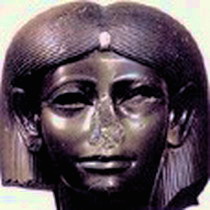
The Princess who found baby Moses in a basket amongst the reeds of the Nile. Her father Amenemhet III had directed the Egyptian midwives to kill all Hebrew children, She adopted Moses and raised him as an Egyptian.
Sobeknefru reigned over Egypt for 4 years at the end of the 12th dynasty (End of the Middle Kingdom). When she died, the 12th dynasty ended as she had no heirs to take over the throne. She is thought to have been the Princess that found Moses floating in a basket among the reeds of the Nile at a time when her father / grandfather Amenemhet III / Sesostris III was ordering that the babies of the Hebrew slaves be killed by drowning them in the Nile. Sobeknefru adopted Moses and brought him up as her own son. She groomed Moses to be the next pharaoh Amenemhet IV. Moses may have even co-reigned with Amenemhet III for 9 years as Amenemhet IV. Amenemhet IV suddenly disappeared before the death of Amenemhet III leaving no male heirs to take over the throne when he died. Consequently, Sobekneferu became the first Queen of Egypt. She only reigned for 4 years (possibly 8 years). Her Kingdom included Upper and Lower Egypt, Elephantine and Lower Nubia. Revised dates of her reign: 1483-1479 BC (approximately)
Amenemhet I was the founder of the 12th dynasty. He was the vizier of his predecessor Mentuhotep IV who he may have assassinated.

- The Amenemhet I pyramid at El-Lisht.
Amenmehet I was a vizier of Mentuhotep IV of the previous dynasty. He was not of royal descent. He is thought to have overthrown Mentuhotep IV and founded the 12th dynasty.
The 12th dynasty lasted almost 200 yrs and was essentially the Middle Kingdom of Egypt.
The pyramids of the 12th dynasty characteristically had a core that was made out of mudbricks and an external veneer that was made from limestone.
A large slave labour force was needed to make the mudbricks.
A workers village was found by Petrie in 1891 at Kahun. He found scarabs from the time of Sensuret II that indicated that it was occupied during the 12th dynasty up until the 13th dynasty. He also found evidence of a sudden exodus from the village in the 13th dynasty. He thought that many of the semitic slaves were Isralites.
Joseph came to Egypt at the age of 30 yrs and was 110 yrs when he died. The Jews lived in Egypt 430 years and then Moses lead them out of Egypt (The Exodus). The Israelites numbered only 70 when they came to Egypt in the ?third dynasty. By the 12th dynasty, they numbered over a million and the pharaoh had long forgotten their connection to Joseph (?Imhotep) who had saved Egypt from famine and may even have built the first pyramid.
The Amenemhet III pyramid at Hawara. The Last of the Great Pyramids. Like other 12th dynasty pyramids, the mud bricks in it’s core were probably made by Hebrew slaves.
Amenemhet III was the 6th pharaoh of the 12th dynasty of Egypt. He built 2 pyramids; the Black Pyramid at Dashur and this one at Hawara.
While the pyramids of the Old Kingdom were made of solid limestone blocks, the 12th dynasty (Middle Kingdom) pyramids had a core that was made of bricks (containing mud and straw) and an outer veneer of limestone.
Over the centuries, the outer veneer has fallen down as a result of erosion and earth quakes or stolen by people to be used elsewhere. What remains is the mud brick core which has been eroded further by the weather.
If you look carefully, the straw within the mud bricks is still quite easy to see.
It would have taken an enormous number of slaves to make this number of mud bricks, let a lone assemble them.
It is likely that the mud bricks in these 12th dynasty pyramids were made by Hebrew slaves prior to the Exodus.
Amenemhet III would have been the Pharaoh that Moses fled from.
When the Exodus took place in 1445 BC, there were not enough slaves left in Egypt to make mud bricks and so no more pyramids were built.
The dates do not match with the traditional dates calculated from Manetho because many dynasties and regencies ran in parallel and some dynasties have been counted twice. The Egyptian Chronology needs to be revised and then it will match the Biblical Chronology.
Amenemhet III – The Pharaoh who allowed his daughter / sister (Sobeknefru) to adopt Moses.
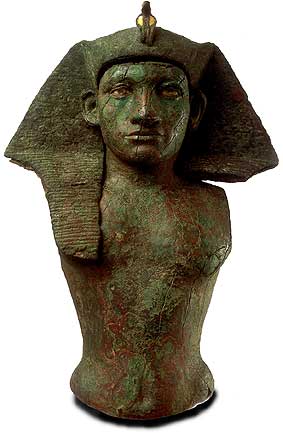
Amenemhet III - 6th Pharaoh of the 12th Dynasty - The Pharaoh whom Moses fled from. When Moses was 40 yrs old he had to flee to Midian after killing an Egptian official.
http://www.answersingenesis.org/articles/utp/pharaohs-of-the-oppression

